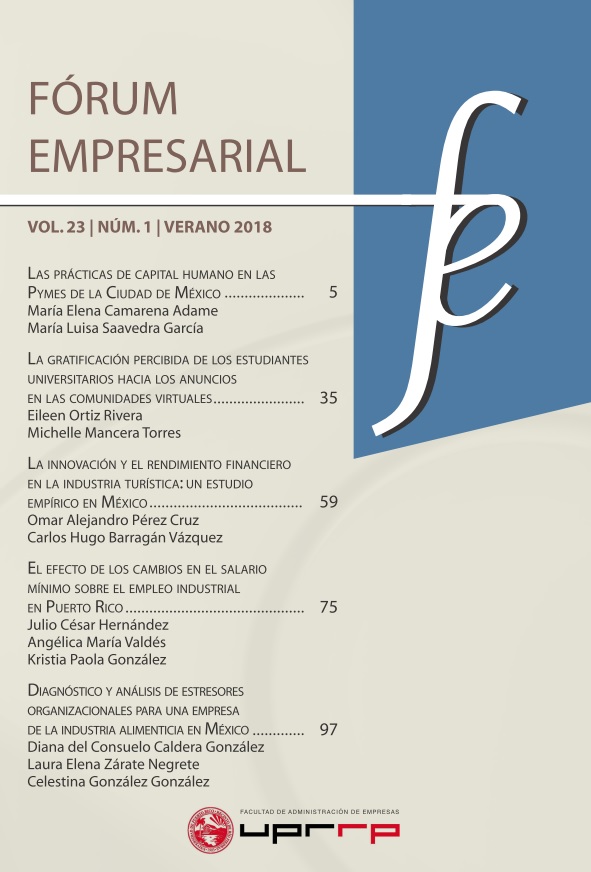Abstract
This paper examines the perceived enjoyment of college students toward ads in online social networks. A questionnaire was administered to a sample of 147 students from a higher education institution in Puerto Rico. The research ex-amined the social influence variables and the advertising-related variables in online social networks. Findings indicate that perceived enjoyment of college students positively affects the group norms, group intention, perceived ad relevance and response to social networks ads. In this way, the ads can be directed to consumers according to their interests, values, and beliefs within the virtual community, thus maximizing the use of social networks as a digital marketing tool.References
Bagozzi, R., & Yi, Y. (1988). On the evaluation of structural equation models. Journal of the Academy of Marketing Science, 16(1), 74–94.
Belch, G., & Belch, M. (2005). Publicidad y promoción, perspectiva de la comunicación de marketing integral (6a ed.). México, D. F., México: McGraw Hill.
Belch, G., Belch, M., Kerr, G. & Powell, I., (2009). Advertising and promotion: An integrated marketing communication perspective. Sydney, Australia: McGraw Hill.
Bond, C., Ferraro, C., Luxton, S., & Sands, S. (2010). Social media advertising: An investigation of consumer perceptions, attitudes, and preferences for engagement. En P. Ballantine, & J. Finsterwalder (Eds.), Proceedings of the Australian and New Zealand Marketing Academy (ANZMAC) Conference 2010-'Doing More with Less‘ (pp. 1–7). Christchurch, New Zealand: Department of Management, University of Canterbury.
Caldevilla-Domínguez, D. (2010). Las redes sociales. Tipología, uso y consumo de las redes 2.0 en la sociedad digital actual. Documentación de las Ciencias de la Información, (33)45–68. Recuperado de https://tinyurl.com/y2uc5oxs
Cohen, J. (1988). Statistical power analysis for the behavioral sciences. New York, NY: Lawrence Erlbaum.
Dholakia, U. M., Bagozzi, R. P., & Pearo, L. K. (2004). A social influence model of consumer participation in network- and small-group-based virtual communities. International Journal of Research in Marketing, 21(3), 241–263. Recuperado de https://doi.org/10.1016/j.ijresmar.2003.12.004
Duhan, P., & Singh, A. (2013). Impact of usefulness, ease of use, enjoyment, attitude and subjective norms on behavioral intentions and adoption of virtual communities: An Empirical Study. Journal of IMS Group, 10(2), 19–31.
Fornell, C., & Larcker, D. F. (1981). Evaluating structural equation models with unobservable variables and measurement error. Journal of Marketing Research, 18(1), 39–50.
Hair, J. F., Hult, G. T. M., Ringle, C. M., & Sarstedt, M. (2017). A primer on partial least squares structural equation modeling (PLS-SEM). Los Angeles, CA: SAGE Publications.
Geyer, F. (1996). Virtual communities in cyberspace. Kybernetes, 25(4), 60–66. http://dxd.doi.org/10.1108/03684929610118345
Kaplan, A., & Haenlein, M. (2010). Users of the world, unite! The challenges and opportunities of social media. Business Horizons, 53(1), 59–68.
Kayode, B. K., Zamzami, I. F., & Olowolayemo, A. (2012). Students‘ orientation towards interpersonal communication in online social networking sites. Multicultural Education & Technology Journal, 6(1), 36–44. https://doi.org/10.1108/17504971211216300
Krejcie, R. V., & Morgan, D. W. (1970). Determining sample size for research. Educational and Psychological Measurement, 30, 607–610.
La Rosa Pinedo, A. (2010). Redes sociales en la web, comunicación y comportamiento social. Avances en Psicología, 18(1), 85–95. Recuperado de https://docplayer.es/3070008-Redes-sociales-en-la-web-comunicacion-y-comportamiento-social.html#show_full_text
Lee, C. (2010). The interplay between media use and interpersonal communication in the context of healthy lifestyle behaviors: Reinforcing or substituting? Mass Communication and Society, 13(1), 48–66. https://doi.org/10.1080/15205430802694869
Maggiani, R. (2014). Social media and its effect on communication: Multidimensional interactions have altered the basic rules of communication. Recuperado de http://www.solari.net/position-papers/social-media/Solari-Social-Media-and-Communication.pdf
Martínez-Gutiérrez, F. (2014). Las redes sociales: Una aproximación conceptual y una reflexión teórica sobre los posibles usos y gratificaciones de este fenómeno digital de masas. Estudios de Tecnología y Comunicación, 1, 1–11. Recuperado de https://dialnet.unirioja.es/servlet/articulo?codigo=6345794
Millward Brown‘s Dynamic Logic. (2010). Brands + consumers + social media: What marketers should know about who‘s getting social and why. Recuperado de http://es.slideshare.net/MillwardBrown/dynamic-logic-adreaction-what-marketers-should-know-about-whos-getting-social-why
Porter, C., Donthu, N., Mac Elroy, W., & Wydra, D. (2011). How to foster and sustain engagement in virtual communities. California Management Review, 53(4), 80–110.
Saleem, F. (2013) Acceptance of SMS advertising in young Pakistani consumers. Journal of Business & Economics, 5(2) 206–227.
Soares, A. M., & Pinho, J. C. (2014). Advertising in online social networks: The role of perceived enjoyment and social influence. Journal of Research in Interactive Marketing, 8(3), 245–263. https://doi.org/10.1108/JRIM-08-2014-001
Taylor, D. G., Lewin, J. E., & Strutton, D. (2011). Friends, fans, and followers: Do ads work on social networks? How gender and ages shape receptivity. Journal of Advertising Research, 51(1), 258–275. Recuperado de https://pdfs.semanticscholar.org/a913/596386edaa3bd4839f1930aac5723387faea.pdf
Valenzuela-Fernández, L., Martínez-Troncoso, C., & Jerez-Yáñez, O. (2013). Comunidades de marca virtuales en redes. Global Conference on Business and Finance Proceedings, 8(2), 1440–1449.
Van der Heijden, H. (2004). User acceptance of hedonic information systems. MIS Quarterly, 28(4), 695–704.
Van-Tien Dao, W., Nhat Hanh Le, A., Ming-Sung Cheng, J., & Der Chao, C. (2014). Social media advertising value: The case of transitional economies in Southeast Asia. International Journal of Advertising, 33(2), 271–294. https://doi.org/10.2501/IJA-33-2-271-294
Venkatesh, V. (2000). Determinants of perceived ease of use: Integrating control, intrinsic motivation, and emotion into the technology acceptance model. Information systems research, 11(4), 342–365.
Zeng, F., Huang, L., & Dou, W. (2009). Social factors in user perceptions and responses to advertising in online social networking communities. Journal of Interactive Advertising, 10(1), 1–13. Recuperado de https://doi.org/10.1080/15252019.2009.10722159

This work is licensed under a Creative Commons Attribution-NonCommercial-ShareAlike 4.0 International License.
Copyright (c) 2018 Fórum Empresarial

